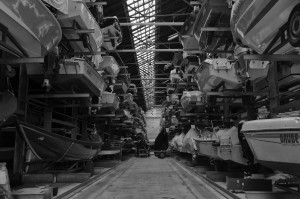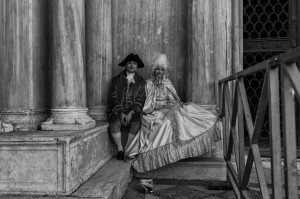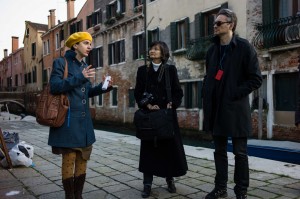I was in Venice last week. It was a labyrinth dripping with the secrets of old ceremonies. The sounds of nearly still water slopping up against the steps leading from the streets were the only perceptible movements. Which is strange. I come from a town with paving conditions dominated by asphalt, where Suburbans and Range Rovers choke out sidewalks and bike lanes from the street life. It took me ten hours of being stranded on the fish-shaped island of Venice to realize that there were no motor vehicles anywhere. (Well, there are water taxis and boats, but nothing else) In fact, most of my fellow students were torn, and the breaking point happened to be the movement of the venetian city. The water and the pre-motor age engineered streets. They were either mad that they couldn’t find their way, or grateful for the uncertainty.
On the ceremonial canals and secretive streets of the islands of Venice, every factor from a private garden, to a well, to the organization of buildings around a square can tell elude to an architectural concept such as buffer, sustainability, or community. It was interesting to see Carnevale commencing on each calle of Venice. (Fun fact, Carnevale = ‘meat’ ‘goodbye’, as in the period of fasting before Easter initiated by Ash Wednesday)
Squeezing through the alleys at night with masked men was certainly a trip. We paid visits to works by Scarpa, like the Querini Stampalia, where the same kind of layering, in this case a material layering of youthfully cut marble against the old archways of a palazzo whose years greatly exceeded the Scarpan intervention. Each material and move illuminated the vast history of tradition and heritage within Venice. The way that the water engaged with the building gave way to the greater urban relationship to water and structure. And just above the first floor we were clued in by painters Longhi, Ghidoni, and one anonymous genre painter as to the civic life of Venice circa the 18th century.
Then we were all pulled away. Traveling through the countryside by bus, or pullman as the Italians call it, I noticed that highways seemed pretty alien to the land there. They were just these huge concrete nuisances stuck into the farms, plains, vineyards, and hills. And if you look at a map of all the autostrade in Italy, there are virtually two long roads which run like zipper up the length of the boot that is Italy. No more, no less. Only one of the two connects to Sicily. It was amazing to see so visibly the great conflicts of history before me, elicited by one vast stretch of road.
The motor vehicle lifestyle is so deeply ingrained in American culture, it’s absolutely insane! One could argue that the fabric which surrounds the highway was built in mind for the driver, and vice versa, with the street framing the scenery. My fellow Cornellians can attest to the knifelike way that route 17 or I-81 pare through the mountainous curves of the northeast, like twin rivers.
Such conflict inspires architecture sometimes, for example the Church of the Autostrada, whose form pointed fingers to Ronchamp. The curving, pitched tent roof and swooping spaces paid homage to the fallen who had struggled to pave the autostrada for pilgrims like us today. If I’ve learned anything from this trip, it’s that movement, whether fast and direct like the autostrada, or winding and surreptitious like the canal and calle, can become the greatest inspiration for structure.



